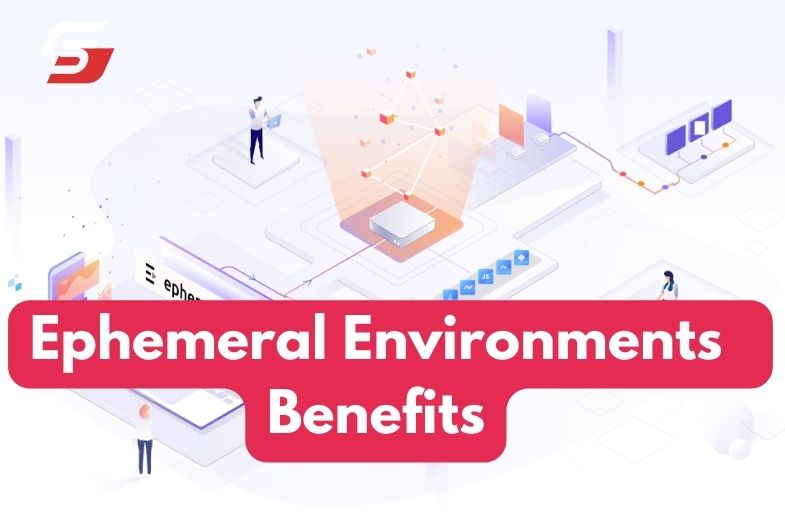The use of ephemeral environments has become a game-changer in the dynamic field of software development, providing development teams with a host of benefits. These environments play a significant role in product testing and deployment.
This blog post will take you through effective ways in which ephemeral environments can support a development approach that is more efficient and productive.
Ephemeral Environments Explained
During the software development process, temporary and disposable development environments are built, used, and then discarded. These environments are known as ephemeral environments. Ephemeral environments, in contrast to traditional, persistent environments, are intended to be transient and provide a dynamic and adaptable approach to the development lifecycle.
These environments are made when needed, have a function, and are removed after it is accomplished. This concept aligns with the agile and iterative nature of modern software development, emphasizing adaptability, efficiency, and reproducibility. Hence, you must have a complete guide to ephemeral environments before implementing this approach in your development processes.
Important Features of Transient Environments
Transience: The fleeting quality of ephemeral settings is one of their defining characteristics. They are not meant for long-term use; instead, they are designed for specialized tasks like testing, debugging, or feature development. These settings are only transitory, so every iteration of the development process has a clean, consistent beginning.
On-Demand Creation: Ephemeral environments are created on demand, in contrast to typical environments, which are configured and maintained continuously. These environments can be created by developers on demand, which lowers the overhead involved in keeping up persistent development spaces. The agile concept of concentrating on what is essential at that particular point in the development cycle is in line with this on-demand creation.
Purpose-Specific: Ephemeral settings are created with a particular goal in mind. Every environment has a specific purpose, whether it’s debugging a problem, performing QA (Quality Assurance), or testing a new feature. The development workflow’s efficiency and clarity are improved by this goal-driven strategy.
Purpose-Specific: Reproducibility is a fundamental feature of transient situations. Because each instance of these environments is built from a specified configuration, consistency is guaranteed. Its repeatability makes it easier for team members to collaborate, test, and debug consistently, which lowers the possibility that problems may arise from changes in the environment.
Disposable: Because ephemeral environments are disposable, they can be thrown away after serving a purpose. This dispensability is consistent with the “Infrastructure as Code” (IaC) paradigm, which treats environments as simply replicable code. Additionally, it reduces the possibility of “environmental drift,” or discrepancies resulting from development-related changes that may occur in long-standing situations.
Benefits of Ephemeral Environments for Development Teams
1. Rapid Testing and Prototyping
Ephemeral environments excel in providing a swift and efficient platform for testing and prototyping. Developers can instantly create isolated instances to experiment with new features, configurations, or libraries without affecting the main codebase. This rapid testing capability accelerates the iterative development cycle, enabling teams to iterate quickly and refine their code with minimal friction.
2. Isolation for Parallel Development
Ephemeral environments offer a solution to the challenge of parallel development by providing isolated spaces for different branches or features. This isolation ensures that multiple developers can work concurrently on distinct aspects of the project without interfering with each other. The ability to parallelize development tasks fosters collaboration and significantly expedites overall progress.

3. Enhanced Collaboration
The ephemeral nature of these environments simplifies collaboration among team members. Developers can effortlessly share their development state by sharing the environment configuration, promoting collaborative problem-solving and knowledge sharing. This streamlined collaboration is especially valuable for tackling complex issues or collectively addressing challenges within the development process.
4. Consistent Testing Environments
Ensuring consistent testing environments is a critical aspect of reliable software development. Ephemeral environments, starting with a clean slate for each testing session, facilitate the reproduction of identical environments. This consistency minimizes issues related to inconsistent dependencies or configurations that might arise in long-standing testing environments, leading to more accurate and reliable testing results.
5. Resource Optimization
Ephemeral environments contribute to efficient resource utilization by allowing developers to allocate resources only when needed. Traditional development environments, often running continuously, can tie up resources unnecessarily. With ephemeral environments, resources are allocated dynamically, optimizing the use of infrastructure and contributing to a more cost-effective development process.
6. Improved Deployment Confidence
Confidence in the deployment process is paramount for a successful release. Ephemeral environments, mirroring production closely, instill confidence that the tested code can seamlessly transition to production. By reducing the likelihood of deployment-related issues, development teams can proceed with releases more confidently, leading to a more reliable and predictable deployment process.
7. Scalability and Flexibility
Ephemeral environments offer unparalleled scalability and flexibility. Whether the development team is working on a small feature or a large-scale project, these environments can be adjusted to match the scope and requirements. This scalability ensures optimal performance and adaptability to the dynamic needs of the development workflow.
8. Quick Bug Identification
Bugs are an inevitable part of software development, and identifying & resolving them promptly is crucial. Ephemeral environments make it easier to isolate and reproduce bugs. Developers can share the specific environment configuration where the issue occurred, facilitating faster debugging and resolution without disrupting ongoing work.
9. Reduced Environmental Drift
Traditional development environments often suffer from “environmental drift” over time, where inconsistencies arise due to changes made during development. Ephemeral environments, being temporary and reproducible, help minimize environmental drift by starting fresh with each iteration. This ensures a clean and consistent development state, reducing unexpected issues related to environmental variations.
10. Time and Cost Savings
Development teams can save a lot of time and money by quickly creating and undoing ephemeral environments. Developers can concentrate more on creating code and handling important development chores by cutting down on the time spent setting up and maintaining environments. Ephemeral environments are a financially smart solution for enterprises because of these time efficiencies, which directly translate into cost reductions.
Revolutionizing Software Development Practices
The adoption of ephemeral environments transforms how development teams approach software development. The benefits range from accelerated testing and parallel development to enhanced collaboration, resource optimization, and improved deployment confidence.
By integrating these dynamic environments into their workflow, development teams can harness the power of agility and efficiency, delivering higher-quality software in a more streamlined and cost-effective manner.


